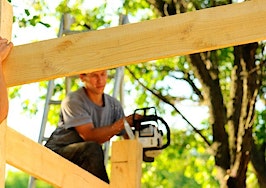- In July, total existing-home sales fell 3.2 percent to a seasonally adjusted annual rate of 5.39 million in July -- down from 5.57 million in June.
- Low inventory and complications arising from appraisals are to blame, says NAR.
For four straight months, home sales have been steadily climbing, according to the National Association of Realtors. In May, existing-home sales boasted their highest pace in nine years.
But during this time, the dark overhang of tight inventory has never dissipated from the housing market conversation. And it appears that this restraint has finally superseded buyer momentum fueled by low mortgage rates, which dropped from 3.57 percent in June to 3.44 percent last month — the fifth consecutive month of rate decline.
In July, total existing-home sales fell 3.2 percent to a seasonally adjusted annual rate of 5.39 million in July — down from 5.57 million in June.
“For only the second time in the last 21 months, sales are now below (1.6 percent) a year ago (5.48 million),” NAR noted in a press release.
The only region to see an increase in monthly closings was the West.
[Tweet “@Trulia’s Ralph McLaughlin: ‘Homebuyers remain stifled by anemic inventory.'”]

Source: NAR
Lawrence Yun: Affordability is to blame
NAR’s chief economist Lawrence Yun connected the slump in transaction closings to one major factor: the upward price pressure caused by fewer homes on the market.
“Severely restrained inventory and the tightening grip it’s putting on affordability is the primary culprit for the considerable sales slump throughout much of the country last month,” he said. “Realtors are reporting diminished buyer traffic because of the scarce number of affordable homes on the market, and the lack of supply is stifling the efforts of many prospective buyers attempting to purchase while mortgage rates hover at historical lows.
“Furthermore, with new condo construction barely budging and currently making up only a small sliver of multi-family construction, sales suffered last month as condo buyers faced even stiffer supply constraints than those looking to purchase a single-family home.”
Yun’s comments are reflected in July’s median existing-home price for all housing types, which came in at $244,100, up 5.3 percent from July 2015 ($231,800). This represents the 53rd consecutive month of year-over-year price gains.
He added: “Although home sales are still expected to finish the year at their strongest pace since the downturn, thanks to a very strong spring, the housing market is undershooting its full potential because of inadequate existing inventory combined with new home construction failing to catch up with underlying demand.
“As a result, sales in all regions are now flat or below a year ago and price growth isn’t slowing to a healthier and sustainable pace.”

Source: Trulia
Trulia’s chief economist Ralph McLaughlin also weighed in on NAR’s latest report: “Comparing yesterday’s stellar new home sales numbers with today’s existing home sales tells an important tale of two housing markets,” he said in an emailed statement. “Homebuilders continue to thrive on healthy demand while homebuyers remain stifled by anemic inventory.”
Buyer and builder breakdown
The share of first-time buyers purchasing homes in June 2016 was the highest recorded since July 2012: 33 percent. That dropped slightly to 32 percent in July, which is still up from the 28 percent share recorded a year ago.
Single-family home sales modestly contributed to the overall decline with a 2.0 percent drop to a seasonally adjusted annual rate of 4.82 million in July from 4.92 million in June.
[Tweet “NAR’s Lawrence Yun: ‘The housing market is undershooting its full potential.'”]
Compared to a year ago when the rate pace stood at 4.86 million, single-family sales are down 0.8 percent. In this category, the median existing price was $246,000 in July, a substantial rise of 5.4 percent from July 2015.
Existing condominium and co-op sales experienced an even bigger drop of 12.3 percent to a seasonally adjusted annual rate of 570,000 units in July from 650,000 in June, and a median year-over-year price increase of 4.1 percent to $228,400.
How did buying patterns vary across the country?
- In the Northeast, existing-home sales dropped 13.2 percent to an annual rate of 660,000, now 5.7 percent below a year ago. Median price: $284,000, a 3.3 percent year-over-year rise.
- In the Midwest, existing-home sales descended 5.2 percent to an annual rate of 1.28 million in July (level with a year prior). Median price: $194,000, up 5.0 percent year-over-year.
- In the South, existing-home sales dipped 1.8 percent to an annual rate of 2.22 million — 1.8 percent down from July 2015. Median price: $214,500 (year-over-year growth of 6.6 percent).
- The West was the exception — existing-home sales rose 2.5 percent to an annual rate of 1.23 million in July. However, this is still 0.8 percent down from year ago. Median price: $346,100, 6.4 percent above July 2015.
In addition to low inventory, NAR president Tom Salomone pointed to another culprit delaying home sales — complications arising from appraisals.
“Appraisal-related contract issues have notably risen over the past year and were the root cause of over a quarter of contract delays in the past three months,” Salomone said. “This is likely a combination of sharply growing home prices in some areas, the uptick in home sales this year and the strong refinance market overworking the already reduced number of practicing appraisers.
“Realtors are carefully monitoring this trend, and some have already indicated they’re extending closing dates on contracts to allow extra time to accommodate the possibility of appraisal-related delays.”
Existing-home sales are based on transaction closings from MLSs and include single-family homes, townhomes, condominiums and co-ops. Seasonally adjusted annual rates are used in reporting monthly data to help accommodate for seasonal variation; the annual rate for any given month represents what the total number of actual sales for a year would be if the pace for that month were maintained for a whole year.








